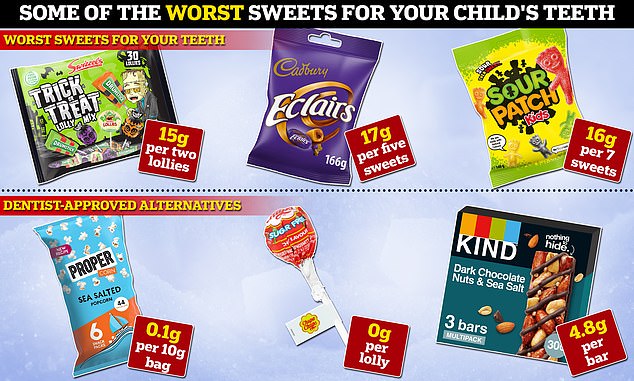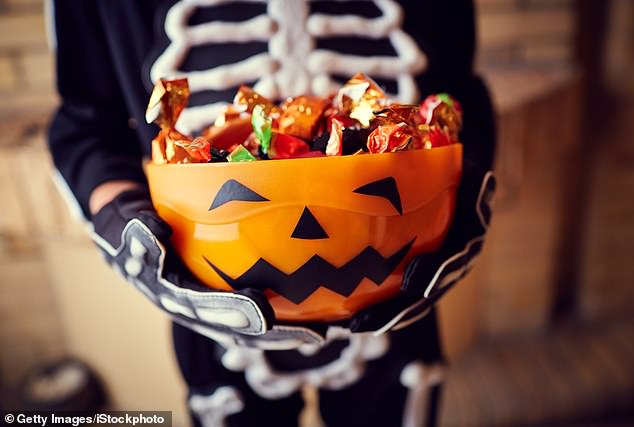Revealed: The Halloween sweets that terrify every dentist because they can be packed with up to 17g of sugar PER HANDFUL… and here’s what they say you should be giving kids instead
This Halloween, stock up on the sour and hard-boiled Trick or Treat candies.
At least that’s the advice of dentists, who say these are the worst options for your child’s teeth.
Some varieties can contain as much as 17 grams of sugar per handful.
Once sugar is broken down in the mouth, it can turn into harmful acid that destroys enamel – the hard outer layer of a tooth. In addition, the combination of acid and saliva can cause plaque buildup.
But parents shouldn’t be too concerned if they see a pile of chocolate bars in their child’s basket on Tuesday evening, experts say.

Sticky, hard-boiled and sour sweets (examples above) are among the worst for teeth, according to dentists, due to their high sugar content. They also pose a risk of chipping teeth and make the mouth so acidic that they can wear away the enamel, they warn. Instead, dentists recommend handing out low-sugar options such as sugar-free gum, jelly candies and yogurt-covered fruit, as well as popcorn and granola bars drizzled with dark chocolate (samples, bottom)

Dentists say it may be better to eat the sweets quickly rather than snacking on them all day
Dr. Richard Marques, a dentist from Harley Street, said: ‘Chocolate is usually slightly better for the teeth than sweets as it can wash off the teeth and leaves less sugar residue than sweets.
‘Pure, dark chocolate is the best chocolate choice over milk chocolate bars when it comes to your teeth, as it generally contains less sugar and more antioxidants.’
But it’s not just about what sweets you eat, but also how you eat them.
It may sound strange, but it may be better to eat chocolate and jelly sweets than to spread out the amount of sweets.
“Taking a packet of sweets in one sitting, say for 30 minutes, is not as bad as eating the same packet of sweets slowly throughout the day,” says London-based dentist Dr Deepak Aulak.
The mouth needs time to balance its pH and combat the sugars, he explained. Sugar lowers the pH of the mouth, making it more acidic, which breaks down tooth enamel.
“If you eat sweets slowly – like sweets that take a long time – it’s worse for the mouth – and it’s a defense against the sugar,” he says.
Dr. Aulak added, “Anything with a high sugar content and a sticky consistency that can get stuck in the teeth is obviously going to be the worst.”
Toffees, such as Cadbury Chocolate Eclairs, are an example of this type of sweet. They contain 17 grams per five candies.
The NHS says children aged four to six should have no more than 19 grams of free sugars – those added to food or drinks – while seven to 10-year-olds should have no more than 24 grams.
Dr. Sam Jethwa, a dentist from Buckinghamshire, recommends avoiding sweets that are ‘particularly sticky’ as these ‘remain on the tooth surface the longest and are also difficult to remove.’
He also recommends avoiding this hard-boiled sweets.
These are “kept in the mouth the longest, which means the mouth is more exposed to sugar,” while biting into them can lead to cracks or chips in the teeth, Dr Jethwa said.
Swizzels Trick or Treat Lolly Mix, which contains chewy Drumstick candies and hard-boiled lollipops, fits into this category. They contain 15 grams of sugar per two lollipops.
Sour candies can also cause an increase in tooth sensitivity and cavities.
Dr. Marques said this is one of the “worst candy choices” for tooth damage.
This is due to ‘the enormous amount of acid’ they contain, which has the potential to wear down the enamel faster than other candies.
“Consumption of sour sweets can cause sensitive teeth, larger cavities and translucent-looking teeth,” he said.
‘Eating sour sweets at other times of the month can also cause taste bud damage, mouth blisters and burns.’
These types of sweets are packed with sugar. For example, there are 16 grams per seven Sour Patch Kids candies.
Dr. Marques recommends passing out low-sugar options on Halloween to reduce the impact on teeth.
He suggests offering sugar-free gum, jelly candies and yogurt-covered fruit, as well as popcorn and granola bars drizzled with dark chocolate.
Ensuring that children drink water after eating sweets so that the pH level in the mouth returns to normal and that they brush their teeth to remove debris is crucial, says Dr Jethwa.
Although children do not have their teeth for life, their baby teeth still need to be cared for, dentists warn.
‘Many people think that because a child still has baby teeth, the effects of sugar on the teeth cannot matter much. But tooth decay can still occur,” says Dr. Jethwa.
‘Symptoms of tooth decay can include sensitivity, swelling and pain of the teeth. In some cases, tooth decay can cause problems with the growth of the adult tooth.”
To help prevent the horrors of cavities and gum disease, dentists say children should brush their teeth with fluoride toothpaste before and after eating sweets.
Dr. Jethwa suggests taking it a step further and flossing to get rid of sticky sweets.
‘Many people assume that flossing is only for adults, but once children have teeth that are touching and food can get stuck between them, they should floss once a day, especially after eating sweets that are particularly sticky. ‘, he says.
